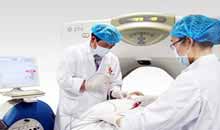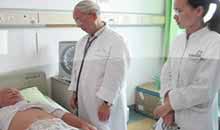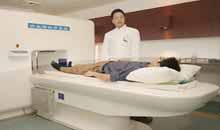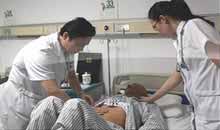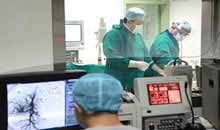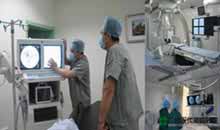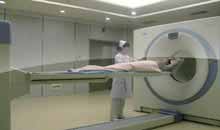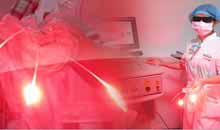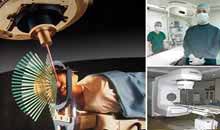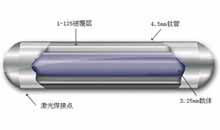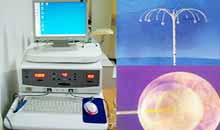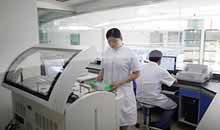What is Cryotherapy?
Cryotherapy, also named cryosurgery therapy or cryoablation, is a medical technique both ancient and modern. As early as thousands of years ago, ice was used to treat infected wounds and various knife injuries. Ar-He knife, a kind of cryotherapy, is the first technique employing space rocket guidance technology in the world and the only technique with efficacies of ultra-low temperature and thermotherapy. Ar-He knife is a precise apparatus approved by the U.S. FDA for accurately targeting and killing cancer cells.
What is the principle of Cryotherapy?
Cryosurgery, made up of ultra-low temperature and thermotherapy, in essence is one of important ablation procedures. The temperature of frozen tumor tissue could reach 120℃~ 165℃ below zero in a dozen of seconds and turn into ice ball when the argon gas is quickly released trough needle point. The tumor tissue inside ice ball is trapped in a "starving and extremely cold "condition -- no blood or oxygen supplies could be maintained in the ultra-low temperature of 165℃ below zero-- and results in coagulation necrosis.
The temperature, in contrast, could reach 20℃~40℃ when Helium is rapidly released through needle point. Then the frozen ice ball is defrosted and blasted, thus tumor tissue is destroyed. The speed and duration of cooling and heating as well as size and shape of ice ball can be precisely designed and controlled.
Cryotherapy is suit to treat what kind of tumors?
Nearly all parenchymal or solid cancers are prime candidates for cryosurgery therapy. These malignancies include:
- Liver cancer
- Lung cancer (non-small cell lung cancer)
- Kidney cancer
- Ovarian cancer
- Pharyngeal cancer
- Testicular cancer
- Uterine tumors
- Vaginal cancer
- Pancreatic cancer
- Breast cancer
- Sarcoma and other benign or malignant lesions of bone
- Prostate cancer
- Skin cancer and melanoma
- Head and neck cancer
- Tumor of soft tissues
In addition, cryosurgery therapy can be an effective treatment for the following:
- Retinoblastoma (a childhood cancer that affects the retina of the eye).
- Early-stage skin cancers (both basal cell and squamous cell carcinomas)
- Precancerous skin growths known as actinic keratosis.
- Pre-cancerous conditions of the cervix known as cervical intraepithelial neoplasia (abnormal cell changes in the cervix that can develop into cervical cancer).
What are the advantages of Cryotherapy?
- Ar-He cryosurgery therapy is one of the minimal invasive techniques, which has no necessity of surgery, with little bleeding and little harm to patient, with high successful rate and low complication rate.
- Under ultralow temperature, cryotherapy can destroy cancer cells directly, and activate immune system in body indirectly, so that immunity to cancer in human body can be increased.
- Ar-He cryosurgery therapy is performed under CT or B-USG guidance targeting to the exact location. Generally speaking, it is toxic reaction, and thus patient can get recovered very soon.
- Ar-He cryosurgery therapy is neither chemotherapy nor radiotherapy;it can be done repeatedly according to patient’s condition, so that it will not cause drug resistance.
- Ar-He cryosurgery therapy can be performed alone, and meanwhile, it can be combined with other treatments as well, through which, the effect would be more remarkable.
- For the cases that other treatments can’t be performed or failed to be effective, Ar-He cryosurgery therapy can still work.
How many cycles is it necessary?

For whether cryotherapy is suitable or not, and how many cycles it is necessary, they depend on tumor location and volume. Generally speaking, for the tumors that Ar-He knife can reach at, and structure around which is not dangerous, Ar-He cryosurgery therapy can be chosen. For tumor in some location, if its diameter is smaller than 3cm, one cycle of cryoabltation is enough; if the diameter is between 3cm to 5cm, then one or two cycles should be performed; as to those whose diameter is over 5cm, one cycle is not enough, in that case, patients can receive it repeatedly, and also, patients can receive other therapies combined together.
Usually, tumor shape is irregular, especially for the bigger ones. Cryotherapy can not destroy tumor completely, so doctors will repeat it according to patient’s actual status, besides this method, combination with other therapies can be performed, so that better treatment effect can be achieved.
What are the reactions after Cryotherapy? Will it freeze body?
There are two distinctions for Ar-He cryosurgery therapy: one is it aims directly to tumor, and the other is it can freeze super fast; so that frozen range can be controlled in a reasonable range over tumor location. It may have mild impact to surrounding tissues around tumor, however, it will not cause whole human body frozen, and it will not have obvious injury to human body.
After cryosurgery therapy, local and general reaction might occur. Local reaction means that the skin over punctured area would be with slight swollen pain. Besides, distending pain might occur over cryosurgery therapy region. General reaction is caused by quick destruction of cancer cells. Dead cancer cells would stimulate body and cause some reactions, for instance, the most common ones are fever, chilly, distention, etc. Generally speaking, the reactions would last for 2 to 7 days and would gradually disappear. To different people, different tumors and different locations, the reactions are different. Some are mild, some are severe, and also some people even don’t have any reaction.
Attentions before receiving Cryotherapy
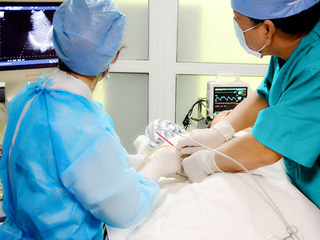
Preparation before treatment: Cryotherapy is a kind of minimal invasive operation, which is different from common surgery. Its preparation is rather simple. Generally speaking, no special preparation is required to patients who will receive treatment under local anesthesia; for patients with general anesthesia, preparation of general anesthesia should be done, for instance, fasting for six hours prior to operation, etc. Pretreatment special recommendation would be told by doctors for patients who are with tumor over special locations or with special status. Please follow suggestions from doctors and nurses and cooperate with the preparation. During the performance, patients only need to stay in a certain body posture, following doctor’s instruction, and besides, patient should cooperate with doctors to do some cooperation action. If there is any discomfort during the performance, please tell doctors directly.
After treatment, doctors and nurses will observe patient’s condition. Some treatment such as intravenous injection and anti-inflammation treatment would be performed. Motor with ECG and others would be given when necessary. In the first two hours after operation, please don’t take food. Usually patients need to stay in bed for a rest for one day, but patients can get up and go to rest room. Operations in different parts would have different requirements, please follow doctors’ advice.
Recommended Links
SUSAN: Interventional Therapy and Biological Immunotherapy Defeat Cancer Recurrence Successfully
MIMIE: Modern Cancer Hospital Guangzhou Gave Me a Second Life
Aida Nuguid: Modern Cancer Hospital Guangzhou Is the Instrument that God Sent to Me


